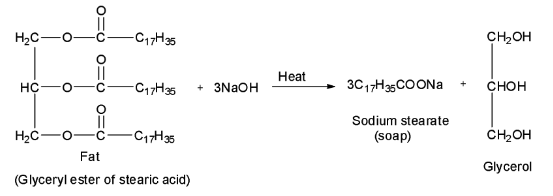
An example of soap is:
A. \[{{\text{C}}_{{\text{17}}}}{{\text{H}}_{{\text{35}}}}{\text{COONa}}\]
B. ${\text{C}}{{\text{H}}_{\text{3}}}{\text{COONa}}$
C. ${\text{C}}{{\text{H}}_{\text{3}}}{\text{ONa}}$
D. \[{{\text{C}}_{{\text{17}}}}{{\text{H}}_{{\text{35}}}}{\text{COO}}{{\text{C}}_2}{{\text{H}}_5}\]
Answer
117k+ views
Hint: Soaps are a class of surfactants which are chemical substances that concentrate at the surface of the solution, form surface films, reduce surface tension of the solution and emulsify grease.
Soaps are actually potassium or sodium salts of higher fatty acids such as lauric acid $\left( {{{\text{C}}_{{\text{11}}}}{{\text{H}}_{{\text{23}}}}{\text{COOH}}} \right)$ or palmitic acid $\left( {{{\text{C}}_{{\text{15}}}}{{\text{H}}_{{\text{31}}}}{\text{COOH}}} \right)$ .
Complete step by step answer:
Soaps are surface active agents and they can remove dirt and dust by emulsifying grease. So, they act as cleansing agents. The molecule of soaps consists of two characteristic groups, one of which is water soluble or hydrophilic and the other is oil soluble or lipophilic.
Soaps are formed by heating fat or oil, or in other words, glyceryl esters of fatty acids with aqueous sodium hydroxide solution. Alcohol is also formed in this process. This process of conversion of fats, oils or lipids into soap and alcohol is known as saponification reaction.
Now, out of the given four options, only the first option is a sodium salt of a higher fatty acid, i.e. \[{{\text{C}}_{{\text{17}}}}{{\text{H}}_{{\text{35}}}}{\text{COONa}}\] is a sodium salt of a higher fatty acid called stearic acid having the formula \[{{\text{C}}_{{\text{17}}}}{{\text{H}}_{{\text{35}}}}{\text{COOH}}\] . Therefore, it is a soap called sodium stearate. It is formed by the saponification of glyceryl ester of stearic acid. Thus, option A is correct.

${\text{C}}{{\text{H}}_{\text{3}}}{\text{COONa}}$ is sodium acetate, ${\text{C}}{{\text{H}}_{\text{3}}}{\text{ONa}}$ is sodium methoxide and \[{{\text{C}}_{{\text{17}}}}{{\text{H}}_{{\text{35}}}}{\text{COO}}{{\text{C}}_2}{{\text{H}}_5}\] is an ester of a higher fatty acid. Therefore, they are not soaps and so the options B, C and D are not correct.
Note:
Soap is a good cleansing agent and is completely biodegradable. Thus, it does not create any pollution problems.
But there are two disadvantages. One of them is soaps cannot be used in hard water because calcium and magnesium ions present in hard water produces curdy white precipitates of calcium and magnesium salts of fatty acids. These get precipitated as scum and some parts of soap is wasted.
Another disadvantage is soaps cannot be used in acidic solutions because acids precipitate the insoluble free fatty acids which adhere to the fabric and thereby lowers the ability to remove oil and grease from the fabric.
Soaps are actually potassium or sodium salts of higher fatty acids such as lauric acid $\left( {{{\text{C}}_{{\text{11}}}}{{\text{H}}_{{\text{23}}}}{\text{COOH}}} \right)$ or palmitic acid $\left( {{{\text{C}}_{{\text{15}}}}{{\text{H}}_{{\text{31}}}}{\text{COOH}}} \right)$ .
Complete step by step answer:
Soaps are surface active agents and they can remove dirt and dust by emulsifying grease. So, they act as cleansing agents. The molecule of soaps consists of two characteristic groups, one of which is water soluble or hydrophilic and the other is oil soluble or lipophilic.
Soaps are formed by heating fat or oil, or in other words, glyceryl esters of fatty acids with aqueous sodium hydroxide solution. Alcohol is also formed in this process. This process of conversion of fats, oils or lipids into soap and alcohol is known as saponification reaction.
Now, out of the given four options, only the first option is a sodium salt of a higher fatty acid, i.e. \[{{\text{C}}_{{\text{17}}}}{{\text{H}}_{{\text{35}}}}{\text{COONa}}\] is a sodium salt of a higher fatty acid called stearic acid having the formula \[{{\text{C}}_{{\text{17}}}}{{\text{H}}_{{\text{35}}}}{\text{COOH}}\] . Therefore, it is a soap called sodium stearate. It is formed by the saponification of glyceryl ester of stearic acid. Thus, option A is correct.

${\text{C}}{{\text{H}}_{\text{3}}}{\text{COONa}}$ is sodium acetate, ${\text{C}}{{\text{H}}_{\text{3}}}{\text{ONa}}$ is sodium methoxide and \[{{\text{C}}_{{\text{17}}}}{{\text{H}}_{{\text{35}}}}{\text{COO}}{{\text{C}}_2}{{\text{H}}_5}\] is an ester of a higher fatty acid. Therefore, they are not soaps and so the options B, C and D are not correct.
Note:
Soap is a good cleansing agent and is completely biodegradable. Thus, it does not create any pollution problems.
But there are two disadvantages. One of them is soaps cannot be used in hard water because calcium and magnesium ions present in hard water produces curdy white precipitates of calcium and magnesium salts of fatty acids. These get precipitated as scum and some parts of soap is wasted.
Another disadvantage is soaps cannot be used in acidic solutions because acids precipitate the insoluble free fatty acids which adhere to the fabric and thereby lowers the ability to remove oil and grease from the fabric.
Recently Updated Pages
How to find Oxidation Number - Important Concepts for JEE

How Electromagnetic Waves are Formed - Important Concepts for JEE

Electrical Resistance - Important Concepts and Tips for JEE

Average Atomic Mass - Important Concepts and Tips for JEE

Chemical Equation - Important Concepts and Tips for JEE

Concept of CP and CV of Gas - Important Concepts and Tips for JEE

Trending doubts
JEE Main 2025: Application Form (Out), Exam Dates (Released), Eligibility & More

JEE Main Login 2045: Step-by-Step Instructions and Details

JEE Main Chemistry Question Paper with Answer Keys and Solutions

Learn About Angle Of Deviation In Prism: JEE Main Physics 2025

JEE Main 2025: Conversion of Galvanometer Into Ammeter And Voltmeter in Physics

JEE Main Exam Marking Scheme: Detailed Breakdown of Marks and Negative Marking

Other Pages
NCERT Solutions for Class 11 Chemistry Chapter 7 Redox Reaction

NCERT Solutions for Class 11 Chemistry Chapter 5 Thermodynamics

NCERT Solutions for Class 11 Chemistry Chapter 8 Organic Chemistry

NCERT Solutions for Class 11 Chemistry Chapter 6 Equilibrium

NCERT Solutions for Class 11 Chemistry Chapter 9 Hydrocarbons

Equilibrium Class 11 Notes: CBSE Chemistry Chapter 6




